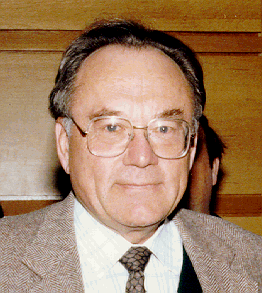
Hermann A. Haus

|
Hermann A. Haus
|
Distinguished Graduate of Rensselaer And Union CollegeSpeaks OnOptical Fibers for Global CommunicationsMonday, November 17, 19974:00 P.M., Sage 3303 |
Abstract: Global communications using optical fibers must be based on long distance submarine cable transmission. The last cable laid in 1995 is capable of transmitting over 270,000 simultaneous phone conversations or an equivalent data transmission rate. We shall start with a description of the laying of the first transoceanic cable around 1857, which transmitted Morse code. The first cable transmitting telephone across the Atlantic was laid in 1956. It had to await the technology developed during and after World War II in order to accomplish reliable transmission over transoceanic distances. It could carry 96 simultaneous telephone conversations. Since then, the transmission capacity of cables has increased in steps, each time in response to technological advances. These advances will be described and explained. The latest advance, which led to the 1995 laying, involved the development of repeaterless all-optical transmission that foregoes detection and regeneration of the signal along the cable. The talk will explain the properties and advantages of optical signal transmission by fiber and the physical obstacles that had to be overcome to arrive at today's transmission capacity. Global fiber cables in the planning stage will be presented. A brief review of the change in the optical fiber communications industry as the result of deregulation will be presented.
Biographical Sketch: Professor Hermann A. Haus was the recipient of the 1987 Charles Hard Townes Award for his analysis of laser noise, the development of the modelocked semiconductor laser, and contributions to the understanding of nonlinear waveguide interactions. He also received the President's 1995 National Medal of Science for his fundamental and seminal research contributions to the the field of quantum electronics, noise and ultra-fast optics; and for his service to the engineering profession through teaching.
Institute Professor Hermann A. Haus was born in Lubljana, Yugoslavia in 1925. After attending the Technische Hochschule, Graz, and the Technische Hochschule, Wien in Austria, he received his Bachelor of Science degree from Union College in Schenectady, New York in 1949. In 1951, he graduated Rennsalaer Polytechnic Institute with a Master of Science in Electrical Engineering, and came to MIT, where he earned his Doctorate of Science and joined the faculty in 1954. He also holds honorary doctor's degrees from Union College, Schenectady, the Technical University of Vienna, Austria, and the University of Ghent, Belgium. He was promoted to Associate Professor in 1958, to Professor in 1962, and to Elihu Thomson Professor in 1973. In 1987, he was conferred the honor of Institute Professor. In over thirty years on the MIT faculty, he has been a prolific contributor to the emerging technologies in the field of optics.
